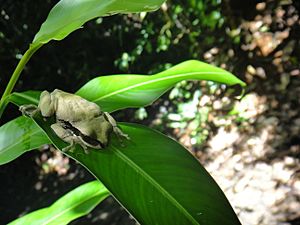Masked tree frog facts for kids
The Masked tree frog is a name that can refer to a few different types of frogs. One of the most well-known is the New Granada cross-banded tree frog, also known by its scientific name, Smilisca phaeota. This amazing frog lives in the warm, wet forests of Central and South America. Another frog sometimes called a masked tree frog is Leptomantis angulirostris, which is found far away in Indonesia and Malaysian Borneo.
Contents
The New Granada Cross-Banded Tree Frog
The New Granada cross-banded tree frog (Smilisca phaeota) is a fascinating amphibian. It is known for its unique appearance and its ability to live in trees. These frogs are an important part of the rainforest ecosystem.
Where Do They Live?
These frogs are found in a wide area, from southern Mexico through Central America, including countries like Costa Rica and Panama. They also live in parts of South America, such as Colombia and Ecuador. They prefer tropical forests, especially areas near streams or other bodies of water where they can lay their eggs. They are often found in lowland forests, which are not very high above sea level.
What Do They Look Like?
The New Granada cross-banded tree frog has smooth skin that can be different shades of brown, green, or gray. They often have darker bands or spots across their back, which helps them blend in with tree bark or leaves. They have large, dark eyes with a golden iris. Like many tree frogs, they have special pads on their toes. These pads help them stick to smooth surfaces like leaves and branches, making them excellent climbers. Adult frogs are usually about 5 to 7 centimeters (2 to 2.8 inches) long.
What Do They Eat?
These frogs are carnivores, meaning they eat other animals. They mostly hunt insects and other small invertebrates. They are nocturnal, which means they are active at night. They wait for their prey to come close and then quickly snatch it with their long, sticky tongues. Their diet helps control insect populations in their habitat.
Life Cycle and Reproduction
The life cycle of the New Granada cross-banded tree frog, like other amphibians, involves both water and land. During the breeding season, which often happens during the rainy months, male frogs call out to attract females. They lay their eggs in temporary pools of water or slow-moving streams. The eggs hatch into tadpoles, which are aquatic and breathe with gills. Tadpoles eat algae and other plant matter in the water. As they grow, they undergo metamorphosis, changing into small froglets that can live on land. They develop lungs, lose their tails, and grow legs. These young frogs then leave the water to live in the trees.
See also
 In Spanish: Smilisca phaeota para niños
In Spanish: Smilisca phaeota para niños


